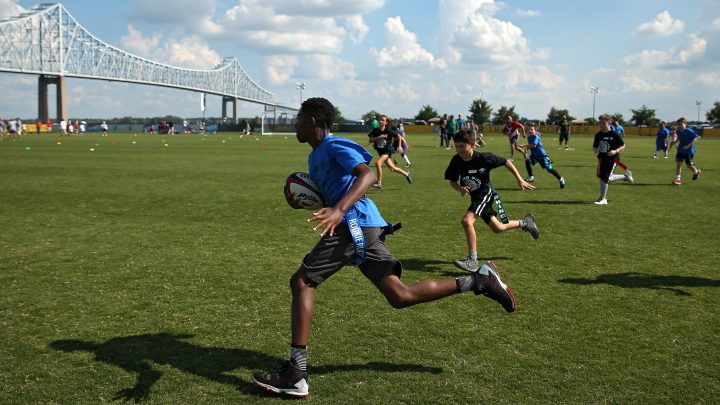
Fewer kids are playing tackle football. Could flag be the future for the NFL?
Fewer kids are playing tackle football. Could flag be the future for the NFL?

Baseball may be called America’s pastime, but looking at television ratings, far and away it’s actually football that Americans are watching. On the list of most viewed prime-time shows in 2023, football games accounted for 28 of the top 30 spots, and viewership was up 7% from the year before.
Participation in youth football, though, is having a very different moment. After tackle football made headlines in the 2010s for concussions and other brain injuries, the youth player population fell as much as 15%.
Yet flag football numbers are on the rise, which could present a different player pipeline — and future — for the NFL.
Dave Sheinin is a sports writer for The Washington Post. He joined Marketplace’s Kai Ryssdal to talk about the paper’s series “The Divided States of Football.”
Kai Ryssdal: Could you do a little compare and contrast, a little before and after, with Pop Warner/Little League football participation before [chronic traumatic encephalopathy] and concussions became a thing and now these days?
Dave Sheinin: Yeah. Basically, participation in youth and high school football has dropped almost every year since the CTE crisis arrived. So we’re talking 12, 13 years now. And basically, high school participation and youth football participation are both down in the vicinity of 10% to 15% in that time. So in terms of high school football players, we’re talking about perhaps 100,000 fewer players now than there were 12-15 years ago.
Ryssdal: And we should say, and this was kind of the point of the series that you and The Post are doing, it is uneven nationally, right? It’s not uniform across the board in every state.
Sheinin: Yeah, that’s what we found. So the 15% figure is, you know, across the country, but there are certain states, certain regions, certain pockets and most importantly, certain demographics where participation has fallen at a much steeper rate.
Ryssdal: List out a couple of them.
Sheinin: For me, honestly, the most fascinating one to me was in terms of the conservative and liberal split or political divide. It’s obviously not as quantifiable as some of the other demographics because, you know, kids who play those sports are not being asked to identify as that. But we’re fortunate enough at The Post to have a fantastic polling department of our own, and they had done a poll in 2012 that asked participants their views on tackle football for kids. You know, back in 2012, the divide between conservatives and liberals was pretty small. It was something like 65% of conservatives recommended football for kids and 61% of liberals. Don’t hold me to those numbers, but it was something like that. And in 2023, that gap had widened to 75% of conservatives would recommend football and only 44% of liberals. So the gap went from, you know, 5 or 7 percentage points up to 30-plus.
Ryssdal: Politics is everywhere, man. So look, the business analogy here is that football has a supply chain problem, right?
Sheinin: Well, they would have, if not for the marketing strategy of sorts by the NFL to embrace flag football. So you create an alternate pipeline, and you also expand your footprint among girls and women into the sport that way. And even if they don’t translate or graduate, I suppose, up to tackle football when they age out of flag, you’ve created a pipeline of athletes, but also a pipeline of fans.
Ryssdal: We should be clear here. It’s not like — I don’t even know what Super Bowl number we’re on. 55? 56? I don’t even know. But Super Bowl 75, when we get there, is not going to be a flag football game, right? That’s not what you’re saying.
Sheinin: You know, I don’t think so, no. But I will say that the NFL very pointedly has been saying for some time now that the future of football is flag, and that’s a direct quote from Troy Vincent, who is the executive vice president, I believe, of football operations for the NFL. So they are, in some ways, setting the stage I suppose for somewhere way, way, way down the line a transfer to flag football as the base model.
Ryssdal: I mean, you got to innovate, right? And football is, if nothing else, in fact mostly, it’s a business.
Sheinin: That’s exactly right. The fall-off in participation in tackle football, that was considered to be somewhat of an existential crisis for the game. And flag football, honestly, it’s a brilliant idea. The critical thing, of course, is going to be transferring those kids out of flag and into tackle when they age up, and we don’t have enough data at this point to know how that’s going.
There’s a lot happening in the world. Through it all, Marketplace is here for you.
You rely on Marketplace to break down the world’s events and tell you how it affects you in a fact-based, approachable way. We rely on your financial support to keep making that possible.
Your donation today powers the independent journalism that you rely on. For just $5/month, you can help sustain Marketplace so we can keep reporting on the things that matter to you.

















